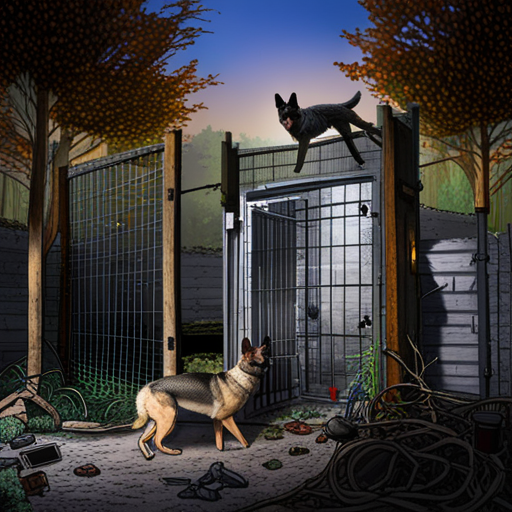As an Amazon Associate I earn from qualifying purchases.
Are you prepared for anything that may come your way?
With a comprehensive bug-out plan, you can ensure your safety and freedom in any situation.
In this article, we will guide you through the process of creating a solid plan that covers all the essential aspects – from choosing the right bug-out location to securing it effectively.
Get ready to take control of your destiny and be prepared for whatever challenges may arise.
Key Takeaways
– Consider accessibility and resources when choosing a bug-out location.
– Stock up on essential supplies and equipment for survival.
– Develop a communication plan with emergency contacts and backup options.
– Create a detailed evacuation route with alternative routes and stay updated on road closures and weather conditions.
Choosing the Right Bug-Out Location

When choosing the right bug-out location, it’s important to consider accessibility and resources. As someone who desires freedom, you understand the need to be prepared for any situation.
One of the first decisions you’ll need to make is whether to opt for a remote or urban bug-out location.
Remote bug-out locations offer solitude and seclusion, allowing you to escape the chaos of urban areas. These areas are often located in the countryside, away from heavily populated regions. They provide a sense of security and self-sufficiency, with ample natural resources such as water and land for farming. However, they may lack access to medical facilities and other essential services.
On the other hand, urban bug-out locations provide the advantage of accessibility to resources and services. They are typically located in or near cities, allowing for easy access to medical care, grocery stores, and other necessary amenities. However, they may also be more vulnerable to civil unrest and have limited access to natural resources.
When selecting a bug-out location, it’s crucial to consider factors such as proximity to your current residence, availability of resources, and the potential risks in the area. Whether you choose a remote or urban location, ensure that it aligns with your goals of freedom and self-sufficiency.
Essential Supplies and Equipment for Survival

Make sure you have all the essential supplies and equipment for your survival.
When it comes to preparing for emergencies and ensuring your freedom, having the right tools at your disposal is crucial.
First and foremost, you’ll need a reliable food storage system. Stock up on non-perishable items that can sustain you for an extended period. Canned goods, dried fruits, and protein bars are great options. Don’t forget to include a water filtration system to ensure a clean water supply.
Next, consider your emergency shelter. While you may have chosen a bug-out location, it’s essential to have a portable shelter as well. A sturdy tent or tarp can provide protection from the elements and give you a sense of security. Remember to include sleeping bags and blankets for added comfort.
In terms of equipment, a multi-tool is a must-have. It can serve multiple purposes and come in handy in various situations. Additionally, pack a first aid kit with essential medical supplies and medications. Other essential items include a flashlight, extra batteries, a fire starter, and a means of communication such as a two-way radio.
Developing a Communication Plan

It’s important to establish a communication plan to ensure effective coordination during emergencies. When you find yourself in a crisis situation, having a reliable way to communicate with your loved ones and other trusted contacts can make all the difference.
Start by establishing emergency contacts, such as family members, close friends, and neighbors who can be relied upon for support and assistance. Make sure to exchange contact information and discuss emergency plans with them in advance.
Next, it’s crucial to establish a communication network that can withstand any disruptions caused by the emergency. Consider using multiple methods such as cell phones, walkie-talkies, and even satellite phones if possible. Keep in mind that during an emergency, traditional means of communication may not be reliable, so having backup options is essential.
In addition to establishing emergency contacts and a communication network, it’s vital to have a designated meeting place in case you are separated from your loved ones. This meeting place should be easily accessible and well-known to everyone involved. It’s also a good idea to establish a code word or phrase that can be used to verify the safety and authenticity of communication during emergencies.
Creating a Detailed Evacuation Route

Establish a detailed evacuation route that includes multiple options and considers potential obstacles or hazards along the way. When it comes to your safety and freedom, having a well-thought-out plan is crucial. Start by mapping out the most direct and efficient routes to various emergency shelters in your area. Consider alternative routes in case the main roads are congested or blocked. Freedom means having options, so make sure your evacuation route allows for flexibility.
Take into account potential obstacles or hazards that could impede your journey. Is there a bridge that could be damaged or a road prone to flooding? Identify these points and find alternative routes to avoid them. Keep in mind that during emergencies, conditions can change rapidly, so stay updated on road closures and weather conditions.
In addition to your primary evacuation route, consider secondary and tertiary routes. This way, if one route becomes compromised, you have alternatives to reach safety. Familiarize yourself with these routes and practice using them regularly.
Ensuring the Safety and Security of Your Bug-Out Location

Ensuring the safety and security of your bug-out location is essential for your peace of mind during times of crisis. When it comes to securing shelter and establishing a perimeter, here are some key steps to consider:
– Securing Shelter:
– Reinforce existing structures: fortify doors, windows, and walls with sturdy materials like metal bars or plywood to prevent unauthorized entry.
– Consider alternative structures: if your primary shelter is compromised, have backup options like tents or underground bunkers that can withstand harsh conditions.
Establishing a Perimeter:
– Install physical barriers: fencing, walls, or barricades can help deter intruders and provide a clear boundary for your bug-out location.
– Implement surveillance systems: set up cameras, motion sensors, or alarms to monitor any potential threats and act as early warning systems.
For the freedom-seeking individual, it is crucial to take proactive measures to protect your bug-out location. By securing shelter and establishing a perimeter, you create a safe haven where you can confidently weather any storm.
Frequently Asked Questions
How Can I Involve My Children in the Bug-Out Planning Process?
Get your children involved in bug-out planning by teaching them survival skills. Show them how to pack a bug-out bag, identify safe locations, and practice evacuation drills. It’s important to prepare them for any emergency situation.
Are There Any Legal Considerations When Choosing a Bug-Out Location?
When choosing a bug-out location, legal considerations are important. You should research zoning restrictions and any laws that may affect your choice. It’s crucial to find a location where you can exercise your freedom effectively.
What Are Some Common Mistakes to Avoid When Packing Essential Supplies for Survival?
When packing essential supplies for survival, common mistakes to avoid include overpacking unnecessary items, forgetting important tools like a knife or fire starter, and not considering the weight and portability of your gear.
How Can I Ensure That My Communication Plan Remains Effective During a Natural Disaster?
To ensure effective communication during a natural disaster, maintain communication channels during emergencies. Keep backup devices charged, use satellite phones or radios, and establish a designated meeting point for your group. Stay connected and be prepared.
Are There Any Additional Measures I Should Take to Protect My Bug-Out Location From Potential Threats or Intruders?
To protect your bug-out location, consider additional security measures such as reinforcing entry points, installing security cameras, and setting up perimeter alarms. These measures will help fortify your location and keep potential threats or intruders at bay.
Conclusion
In conclusion, creating a comprehensive bug-out plan is crucial for ensuring your safety and security in times of emergency.
By choosing the right bug-out location, gathering essential supplies and equipment, developing a communication plan, and creating a detailed evacuation route, you will be well-prepared to face any unexpected situation.
Remember to regularly review and update your plan, as circumstances may change.
With proper preparation and a well-thought-out bug-out plan, you can have peace of mind knowing that you are ready for any challenge that may come your way.
As an Amazon Associate I earn from qualifying purchases.










